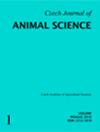Prebiotics supplementation modulates pre-weaning stress in male cattle calves by improving growth performance, health scores and serum biomarkers
IF 1.3
4区 农林科学
Q3 AGRICULTURE, DAIRY & ANIMAL SCIENCE
引用次数: 1
Abstract
Neonatal calves are prone to gastrointestinal infections and microbial dysbiosis that lead to high morbidity and mortality. Prebiotics can be used to mitigate the adverse effects of gut diseases and microbial dysbiosis. Forty male Holstein-Friesian calves (2 ± 1 day old) were divided into four dietary treatments: control (milk without prebiotics), YCW-2, YCW-4 (milk containing 2 or 4 g/day/calf of yeast cell wall, respectively), and cMOS (milk containing commercial mannan-oligosaccharides 4 g/day/calf). Milk intake, feed intake, and health scores were recorded daily, whereas body weight, dry matter intake (DMI), and body measurements were recorded weekly. Feed efficiency (FE) was determined at the end of the trial (eight weeks). Cell-mediated immunity (CMI) was assessed by the topical application of dinitrochlorobenzene. Blood samples were collected fortnightly to determine glucose, non-esterified fatty acid (NEFA), blood urea nitrogen (BUN), and beta-hydroxybutyric acid (βHBA). Cell wall supplemented calves had significantly higher (P < 0.05) final body weights, DMI, and body measurements along with improved (P < 0.05) faecal scores. Feed intake was higher (P < 0.05) in both the YCW-supplemented calves. Glucose was lower (P < 0.001), whereas BUN and βHBA were significantly higher in the YCW-2 animals. No differences were observed in FE, CMI, and NEFA between all the experimental animals. The yeast cell wall (2 g) may have the potential to improve the growth performance and health status of neonatal calves.益生元补充剂通过改善生长性能、健康评分和血清生物标志物来调节公牛犊断奶前的应激
新生小牛容易发生胃肠道感染和微生物失调,导致高发病率和死亡率。益生元可用于减轻肠道疾病和微生物微生态失调的不良影响。将40头荷斯坦-弗里斯坦公牛犊(2±1天大)分为四种饮食处理:对照(不含益生元的牛奶)、YCW-2、YCW-4(每头小牛分别含2或4克酵母细胞壁的牛奶)和cMOS(每头公牛含4克市售甘露寡糖的牛奶)。每天记录牛奶摄入量、饲料摄入量和健康评分,而每周记录体重、干物质摄入量(DMI)和身体测量值。在试验结束时(八周)测定饲料效率(FE)。通过局部应用二硝基氯苯来评估细胞介导的免疫(CMI)。每两周采集一次血样,以测定葡萄糖、非酯化脂肪酸(NEFA)、血尿素氮(BUN)和β-羟基丁酸(βHBA)。补充细胞壁的小牛的最终体重、DMI和身体测量值显著较高(P<0.05),粪便评分也有所改善(P<0.05)。添加YCW的两种小牛的采食量均较高(P<0.05)。YCW-2动物的血糖较低(P<0.001),而BUN和βHBA显著升高。在所有实验动物之间,FE、CMI和NEFA没有观察到差异。酵母细胞壁(2g)可能具有改善新生小牛生长性能和健康状况的潜力。
本文章由计算机程序翻译,如有差异,请以英文原文为准。
求助全文
约1分钟内获得全文
求助全文
来源期刊

Czech Journal of Animal Science
Agriculture, Dairy & Animal Science-奶制品与动物科学
CiteScore
2.40
自引率
16.70%
发文量
44
审稿时长
5 months
期刊介绍:
Original scientific papers and critical reviews covering all areas of genetics and breeding, physiology, reproduction, nutrition and feeds, technology, ethology and economics of cattle, pig, sheep, goat, poultry, fish and other farm animal management. Papers are published in English.
 求助内容:
求助内容: 应助结果提醒方式:
应助结果提醒方式:


